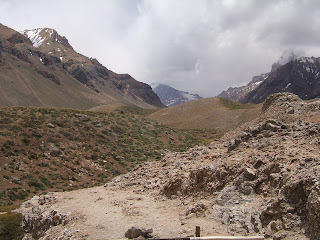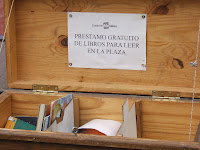 |
| Parque Provincial Aconcagua |
 |
| Plaza España, Mendoza |
We rode the overnight bus back to Rosario from Mendoza last night, luxuriating in coche came comfort–except that my legs are a little short to take full advantage of the footrest. Dozing off, I composed a brilliant blog post in my head. What follows may or may not resemble that ur-post, that gem of observation and clever phrasing, that witty repast for the hungry soul (dinner on the bus was especially bad, and the more disappointing because Thursday night’s bus dinner was quite tasty).
 |
| Open-air lending library in the Plaza España |
Mendoza’s streets are wide, the sidewalks are wide, the trees are abundant. The sycamore bark seems to dapple its own shade into sunlight, or else the other way around. In any event, the effect is restful and we drank it up, along with a bit of the local wine. Not too much, though. Our first wine tasting attempt involved bright orange rental bikes and a couple of kids anxious to take to the road after weeks of city living. Mine are not city kids. So we sacrificed winery tours for the open road (more sycamores, poplars, bougainvillea blooming over doorways, the requisite acres of vines and olive groves) finally ending up at a kind of beer garden. It took some getting to (always, if the signs and friendly locals could be believed, just 300 meters further on), bumping down an unlikely gravel drive to reach a blond-log compound equipped with mismatched chairs and tables, friendly staff, decent craft beer–no wine in sight–and a loose alterna-vibe.
 |
| Surviving chapel, ruined hotel |

On Sunday, we went into the mountains. I’m used to the Andes further north, but these slopes were steeper, less green, more variegated in their reds and yellows and browns. We had some snow, just enough to make us shiver and stomp, and the clouds blocked the views of Aconcagua we’d been hoping to admire. But it was worth the trip. I’ve avoided organized tours, yet I enjoyed the lines of white mini-buses (small, medium, large) carting all of us around, and the sellers of crafts and snake-oil and healing rocks, and the chance to see the jumping off point for a climb my father made almost fifty years ago. He urged us, via email, to enjoy the hot baths and afternoon tea at the hotel at Puente del Inca, but the hotel is no more, lost to a slide only a year or so after Dad was there. The hot springs are now off limits, too, so as to preserve tourists from mishap and protect the natural bridge, adorned as it is (still naturally) in its orange and green mineral wash, drip by dribble by year.
 |
| Puente Picheuta (late c. XVIII) |
 |
Andean quartz, so that health
will not be lacking in your home |
It was all natural and unnatural at once. Centuries of ruins beside the road–Inca tambos, colonial-era stone shelters, disused railroad tracks with cracking avalanche sheds falling down around them, beautifully preserved bridges from the late 1700s and from 1905. A routine itinerary with stops for photo-ops and hot chocolate, vulnerable all the same to weather and rerouting. Or revision. I don’t know if any of this is what I meant to write.
 On Sunday, we went into the mountains. I’m used to the Andes further north, but these slopes were steeper, less green, more variegated in their reds and yellows and browns. We had some snow, just enough to make us shiver and stomp, and the clouds blocked the views of Aconcagua we’d been hoping to admire. But it was worth the trip. I’ve avoided organized tours, yet I enjoyed the lines of white mini-buses (small, medium, large) carting all of us around, and the sellers of crafts and snake-oil and healing rocks, and the chance to see the jumping off point for a climb my father made almost fifty years ago. He urged us, via email, to enjoy the hot baths and afternoon tea at the hotel at Puente del Inca, but the hotel is no more, lost to a slide only a year or so after Dad was there. The hot springs are now off limits, too, so as to preserve tourists from mishap and protect the natural bridge, adorned as it is (still naturally) in its orange and green mineral wash, drip by dribble by year.
On Sunday, we went into the mountains. I’m used to the Andes further north, but these slopes were steeper, less green, more variegated in their reds and yellows and browns. We had some snow, just enough to make us shiver and stomp, and the clouds blocked the views of Aconcagua we’d been hoping to admire. But it was worth the trip. I’ve avoided organized tours, yet I enjoyed the lines of white mini-buses (small, medium, large) carting all of us around, and the sellers of crafts and snake-oil and healing rocks, and the chance to see the jumping off point for a climb my father made almost fifty years ago. He urged us, via email, to enjoy the hot baths and afternoon tea at the hotel at Puente del Inca, but the hotel is no more, lost to a slide only a year or so after Dad was there. The hot springs are now off limits, too, so as to preserve tourists from mishap and protect the natural bridge, adorned as it is (still naturally) in its orange and green mineral wash, drip by dribble by year. 
5 responses to “Bridges real, imagined, or ruined.”
Maybe this post was better than the one you thought of in your sleep. I was right there with you, on the bus, on the hike, at the bridge.
Why do we always imagine the one that got away was the “right” one? Or that seeing the view we’d hoped for, bathing in the hot springs we’d been primed for, would have been “better” than the experience we actually had?
I don’t know that the dream post was better–I just don’t know what it was. But writing always seems to chase after that receding horizon of “just right,” doesn’t it?
nice!
I think you are very adventurous. You love to explore and write things on your own. Keep it up!
Thanks Ana, and Yarra Valley! Australia is still on my list. . .